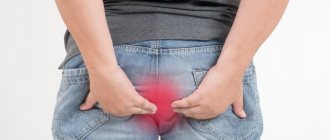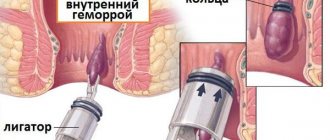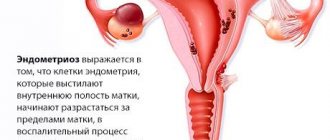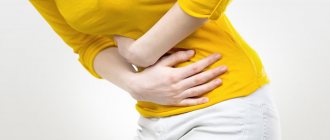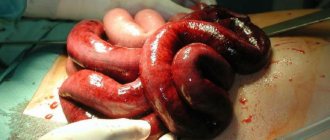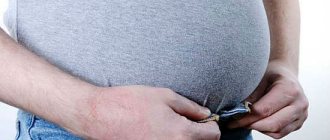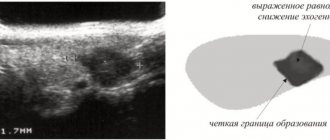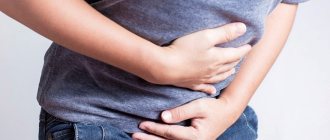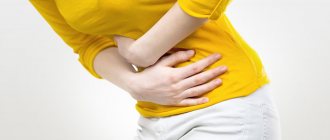February 8, 2021
Pain syndrome is the body’s signal about a pathological process. Abuse of painkillers is not the best solution to the problem. Examination and consultation with a specialist will prevent the development of serious complications.
Pain in the lower abdomen in a man is a symptom of various diseases. These include urological, oncological, neurological pathologies, and disorders of the reproductive system. For qualified help, you can contact the Dr. Medical Center. AkNer. Experienced specialists work here who have all the necessary equipment for diagnosis and treatment.
Diseases of the biliary tract
Biliary colic may manifest itself as pain in the abdomen on the right. The pain is localized in the right hypochondrium and epigastrium (upper abdomen), sometimes radiating to the scapula 1, 2. It is worth noting that if biliary colic occurs, it is important to consult a doctor who will diagnose and prescribe treatment.
Biliary colic is one of the main manifestations of acute cholecystitis against the background of cholelithiasis1. The cause of cholecystolithiasis is gallstones from cholesterol crystals, salts and other substances that block the cystic duct of the gallbladder. This leads to increased pressure in the biliary tract and the occurrence of spasms. In addition, stones and crystals can irritate the lining of the bladder and bile ducts6, 17, 18.
The result is a pain syndrome that ranges from mild to severe. Sometimes it is accompanied by nausea and vomiting, but symptoms of intoxication (fever, weakness) are often absent6. The pain occurs suddenly and lasts from 15 minutes to several hours. The frequency of attacks also varies: from daily to once a year or even less often6.
For pain associated with spasm in diseases of the biliary tract, taking antispasmodic drugs can help1. For example, the active component of the drugs No-shpa® and No-shpa® forte, drotaverine, helps relax the smooth muscles of internal organs (including the biliary tract), helping to relieve pain7, 22.
Pain in the right hypochondrium can be associated not only with cholelithiasis, but also with other diseases of the biliary tract, for example, cholecystitis or papillitis1.
Liver pathology
If the lower abdomen on the right side hurts moderately, this may indicate pathologies occurring in the liver. The organ does not have nerve endings, therefore it itself does not hurt. As a result of inflammation, the size of the liver increases, and it begins to put pressure on neighboring organs, which leads to pain in the right side.
Deterioration in function is indicated by yellowing of the sclera and skin, indigestion, low-grade fever, and changes in the color of feces and urine. If there is an abscess, then sweating increases and muscle discomfort appears.
Pancreatic diseases
Pain usually occurs when this organ becomes inflamed and can be felt in several places. For example, when the head of the gland is affected, it is felt in the right hypochondrium, sometimes taking on a encircling character1. Some people are bothered by nagging and aching pain in the back1.
Pain from pancreatic disease may be worse when a person is lying down, but usually gets better when sitting because the tension on the pancreatic capsule is reduced1.
Pain due to diseases of the pancreas can be constant and painful. Their intensification can be provoked by the nature of the food and drinks taken: with alcoholic pancreatitis, complaints become more intense after eating spicy and sour foods, and with inflammation of the pancreas associated with damage to the ductal system - after eating fatty foods8.
Pancreatic pathology is also characterized by weakness, irritability, insomnia, and decreased performance. From the digestive tract, nausea, vomiting without a feeling of relief, bloating, alternating diarrhea and constipation may occur8.
Recently, the incidence of pancreatitis has been steadily increasing due to alcohol consumption8.
Pain in the left hypochondrium
Topographically, the spleen, jejunum, partially the stomach and pancreas are located in the left hypochondrium. Damage to these organs is always accompanied by the development of pain. Pain in the left hypochondrium is characteristic of pancreatitis, gastritis, gastric ulcer, and jeunitis. The pain varies in nature and intensity and can occur on an empty stomach or after eating. Usually accompanied by despeptic symptoms (vomiting, nausea, belching).
Pain in the left hypochondrium can also signal diseases of the spleen: heart attack, abscess, rupture of the organ. Referred pain in the left hypochondrium occurs with lower lobe left-sided pneumonia, pleurisy, and rib fractures.
Irritable bowel syndrome (IBS)
This condition is not associated with changes in the structure of organs and systems. However, pain with irritable bowel syndrome is almost always observed and is a common symptom overall. Women usually suffer from IBS more often than men. Pain (from moderate to severe) can cover the lower abdomen, including the right side, but is most often localized on the left9. IBS often develops against the background of psychoemotional disorders10.
Symptoms of the disease usually subside in the evening and do not bother patients at night. The pain in some cases spreads to the upper abdomen, radiating to the rectum and epigastric region9-11. An important role in the formation of complaints is played by impaired intestinal motility, accompanied by spasm. As part of complex therapy for IBS, antispasmodics (for example, No-shpu® and No-shpu® forte) can be used, which helps reduce pain7, 12, 22.
Nature of pain and possible causes
When pain in the lower abdomen occurs, an important factor in determining the cause that provoked it is a description of the nature of the pain syndrome:
- With cramping pain, colic, which patients describe as strong, cutting, spasms of the smooth muscles of the “tubular” organs are often diagnosed.
- Aching pain of a chronic nature occurs with cholecystitis or urolithiasis.
- When pain appears suddenly and is immediately severe, appendicitis, diverticulitis, severe intoxication, intestinal obstruction or infection are suspected.
- If the pain is characterized as gradually increasing, which becomes quite severe over time, inflammatory processes of various localizations are suspected.
- Severe pain that subsides after urination occurs due to inflammatory processes in the urinary system.
- If the pain is characterized as acute and widespread throughout the lower abdomen, and the discomfort disappears after defecation, irritable bowel syndrome is suspected.
When contacting a doctor, it is important to remember any details related to the pain syndrome: when it started, under what conditions, other accompanying symptoms, etc. Only in this case will a specialist be able to quickly make a diagnosis and prescribe appropriate treatment, which will allow you to get rid of it in the near future pain.
Urinary tract diseases
Pain on the right side may be caused by urolithiasis. If the right ureter is affected, there may be pain on the right in the abdomen and lower back1, 2. When the stone moves, the pain on the right can move to the lower abdomen, radiate to the genitals, and the inner thighs. If the stone is located in the lower third of the right ureter, the person is bothered by a constant painful urge to urinate2, 13. The pain is usually wave-like in nature, and for spasms in diseases of the urinary tract, the use of antispasmodics, for example No-shpa®, may be indicated or No-shpa® forte7, 13, 16, 22. The passage of stone or sand from the ureter is often manifested by pain and blood in the urine13.
Pain in left side
The left iliac region contains part of the small intestine, the sigmoid colon, and the genitourinary organs - the left ureter, ovary and fallopian tube. When pain in this area is combined with digestive disorders, first of all you should think about intestinal diseases - sigmoiditis, diverticulitis, tumors of the descending colon and sigmoid colon.
In women, the likely cause of pain in the left side may be an exacerbation of left-sided adnexitis. Pain may radiate to the left iliac region due to pathology of the kidneys and urinary tract: urolithiasis, pyelonephritis, ureteritis.
Pain in the lower abdomen on the right side in women
On the right side of women are the right appendages of the uterus: fallopian tube and ovary. With inflammatory diseases of the pelvic organs, there may be pain in the lower abdomen on the right. Pain during the chronic process is aching, spreads to the lower back and suprapubic region, and is often combined with urinary disorders. Exacerbations may be accompanied by chills, nausea, sometimes vomiting, and discharge from the genital tract2, 14.
If the pain in the lower abdomen on the right begins suddenly and sharply, it may be a rupture or torsion of the cyst leg, or an ectopic pregnancy. The right lower abdomen hurts sharply, sometimes leading to fainting, the pain often radiates to the rectum. Patients try not to move so as not to increase the pain. Signs of intoxication and circulatory disorders may gradually appear: pallor, cold sticky sweat, nausea and vomiting, rapid heartbeat, and sometimes bloody discharge appears from the genital tract2, 14. Of course, if such symptoms appear, you must immediately seek medical help.
Pain in the right lower abdomen may periodically occur due to the connection with the menstrual cycle. Pain during menstruation can manifest itself as cramping or be aching and bursting. They often arise in the lower abdomen and then spread to the back, inner thighs, and rectum19-21.
Bowel diseases
Intestinal function is negatively affected by a passive lifestyle, unbalanced diet, drinking alcohol, smoking, and stress. If the intestines are disrupted, heaviness and bloating are felt in the abdomen, diarrhea begins (defecation from 3 to 20 times per day) or, conversely, constipation (the intestines do not empty for more than three days).
With intestinal dysfunction, the pain is nagging, caused by contraction of smooth muscles.
Pain in the right side in men may occur due to inflammation of the appendix, which is an appendage of the cecum and is located between the ilium and the navel. The pathology provokes acute pain, nausea, vomiting, and fever. At first the whole stomach hurts, but after two hours the pain intensifies and is felt in the right side at the very bottom.
The appendix may be located atypically, so pain in the pubic area or lower back is likely
The right side hurts severely and as a result of inflammation of the small intestine (ileitis). Pathology develops due to the activity of pathogenic microorganisms. It is characterized by pain in the side, flatulence, vomiting, nausea, and diarrhea. If the disease becomes chronic, the mucous tissue of the small intestine gradually atrophies.
In Crohn's disease, inflammation can develop in any part of the digestive tract. If the lesion affects the large intestine, then the person feels severe discomfort in the right iliac region, nausea, fever, in addition, vomiting, diarrhea occurs, and weight decreases sharply.
What pain does appendicitis cause?
Ulcerative colitis results in intense, sharp pain on the lower left or right side, depending on where the inflammation is located in the colon.
If there are painful abdominal cramps, belching, constipation, vomiting, then this is probably due to intestinal obstruction. It occurs because motor skills are impaired, as a result of which accumulated food is not evacuated. The pain increases over the course of two days and is characterized as bursting and acute.
As a result of heavy lifting or prolonged tension of the abdominal muscles, a hernia can occur, which can also cause pain in the right lower side. The hernia is most often found in the inguinal canal, where the spermatic cord is located. If its size is significant, then the protrusion can be seen when examining the groin area.
If the hernia is small, it is not visible, but it causes nagging pain in the right side of the lower abdomen (especially during physical activity, coughing or sneezing) and swelling of the scrotum. An inguinal hernia is surgically removed. When a hernia is strangulated (the clinical picture is supplemented by redness of the skin around the protrusion, fever, acute pain with burning when urinating or defecating), peritonitis may begin, which can lead to blood poisoning and death.
Pain in the area of the stomach and intestines can be caused by infectious diseases (botulism, tetanus, salmonellosis, cholera, dysentery) or helminthic infestation.
You can become infected with intestinal infections by consuming contaminated water or food if personal hygiene rules are not followed.
If the intestinal tumor is located on the right side, then it provokes moderate nagging or cramping pain in the right side of the abdomen. At first, the formation of the disease does not provoke painful sensations, but as it develops, neighboring tissues are affected. With colorectal cancer, constipation, bleeding from the anus, pain during bowel movements appear, weight loss and a constant increase in basal temperature are also observed.
Acute appendicitis
Perhaps this is the first pathology that a person thinks about when pain appears in the lower abdomen on the right. The pain in this case does not go away, arising near the navel, and eventually moves downwards1, 2, 15. The sensation may begin as dull, gradually becoming tugging, cutting, burning. A person’s health deteriorates and symptoms of digestive disorders occur: vomiting, bloating, constipation, and sometimes diarrhea15.
Acute appendicitis is treated surgically; if similar symptoms appear, you should immediately call an ambulance1.
Diagnostics
A urologist or gastroenterologist examines men with complaints of pain in the lower abdomen. The examination begins with superficial and deep palpation of the abdomen to identify local soreness and muscle tension. Then a digital examination of the prostate is performed through the rectum - the size and consistency of the gland are determined, and a pain reaction is detected. To find out the cause of the pain syndrome, a full range of diagnostic methods is selected, which includes:
- Ultrasonography
. During an ultrasound of the prostate gland, its shape and size are assessed, local or diffuse changes in the structure are determined. Using Doppler ultrasound, blood flow in the prostate is visualized. An ultrasound of the abdominal cavity is required to exclude inflammatory or tumor processes in the gastrointestinal tract. - Endoscopy
. For chronic pathologies of the urinary tract, the results of urethroscopy and cystoscopy are indicative. For detailed visualization of the condition of the large intestine, sigmoidoscopy and colonoscopy are performed. During endoscopic examination, it is possible to take a biopsy from suspicious areas of the mucosa. - X-ray studies
. If there is a suspicion of urological diseases in men, urethrography and cystography are recommended. If there are symptoms of intestinal damage, irrigography is prescribed. For the diagnosis of large tumors and chronic inflammatory processes, CT of the pelvic organs is informative. - Histological examination
. To verify prostate cancer, a transrectal targeted biopsy is indicated, the material of which is studied under a microscope. Analysis of the microstructure of the intestinal wall is important for the differential diagnosis of UC and Crohn's disease, and the identification of intestinal tumors in men. - Laboratory methods
. Culture of a urethral smear is required to confirm the diagnosis of an STI. Clinical and bacteriological examination of urine helps to establish cystitis and urethritis. In case of dyspeptic disorder, a coprogram is required. If prostate cancer is suspected, a PSA blood test is performed.
Consultation with a urologist
Does your lower abdomen hurt? How to treat?
Treatment of urological problems is a long and scrupulous process. In most cases, only a set of measures can help.
We use methods such as:
- drug treatment;
- physical therapy;
- prostate massage;
- treatment with active oxygen (ozone therapy);
- mud therapy (Dead Sea mud);
- medical and medicinal droppers;
- adjusting the patient’s lifestyle and nutrition;
- development of an individual prevention program;
- monitoring the patient's condition after treatment.
